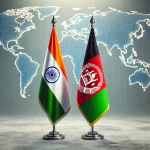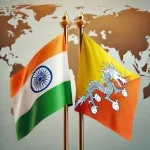About Bangladesh
- Bangladesh is a south Asian nation that shares a border with India and Myanmar with its capital at Dhaka.
Areas of Cooperation
- Historical Relation
- India and Bangladesh share a unique relationship marked by historical, cultural, and linguistic ties.
- Both countries have a shared history, including the struggle for independence and the partition of India in 1947.
- India played a crucial role in the Bangladesh Liberation War of 1971, leading to the independence of Bangladesh.
- 2021 marks fifty years of establishment of relations between the two nations.
- Political Relations
- Diplomatic Relations: India was the first country to recognize Bangladesh as an independent nation in December 1971.
- Cooperation in International Forums: SAARC, BIMSTEC, BBIN, New Development Bank.
- Key Agreements and Treaties:
- Treaty of Friendship: Diplomatic relations were established in 1972.
- Ganga Waters Treaty (1996): Agreement for sharing the waters of the Ganga River during the lean season (January 1 – May 31).
- Land Boundary Agreement (2015): Resolved long-standing border disputes, leading to the exchange of enclaves and the demarcation of the international boundary.
- Kushiyara Pact (2022): Agreement for sharing the waters of the Kushiyara River, benefiting people in Southern Assam and the Sylhet region in Bangladesh.
- Economic Cooperation
- Infrastructure: Farakka Barrage was constructed for sharing the waters of Ganga between the two countries.
- Trade Relations: India is one of Bangladesh’s largest trading partners, with bilateral trade reaching USD 18.2 billion in 2021-22.
- Platform for boosting trade: India Bangladesh CEO forum.
- South Asian Free Trade Area (SAFTA): Bangladesh enjoys duty-free, quota-free access to the Indian market under SAFTA since 2011.
- Border Haats: Establishment of border markets (Border Haats) to promote trade and cultural exchange between border communities.
- Microfinance industry: It started in India in the 1990s by taking inspiration from the Grameen model of Mohammad Yunus.
- Jute industries: Most of the cultivation of jute occurs in India’s West Bengal while the factories of the same are mostly located in Bangladesh.
- Cultural and Social Ties
- Shared Heritage: Both countries share a rich cultural heritage, including the works of Rabindranath Tagore, who wrote the national anthems of both India and Bangladesh.
- Cultural Exchange: Regular cultural exchange programs and festivals to strengthen people-to-people ties.
- Common Language: The shared language of Bengali along with shared cuisines, literary works and others.
- Defence Cooperation
- Joint Military Exercises: India and Bangladesh regularly conduct joint military exercises such as Exercise SAMPRITI and Exercise MILAN to enhance interoperability and mutual understanding.
- Training Programs: Indian military institutions provide training to Bangladeshi defence personnel, fostering stronger military ties.
- Humanitarian Assistance and Disaster Relief (HADR): Both countries collaborate in HADR operations, showcasing their commitment to regional stability.
- Maritime Security: Agreements have been signed to enhance cooperation in maritime security, ocean economy, and space.
- Energy Cooperation
- Power Trade: India exports 1160 MW of electricity to Bangladesh, helping to meet its growing energy demands.
- Joint Projects: Initiatives like the India-Bangladesh Friendship Pipeline enhance energy cooperation and infrastructure development. India supported the installation of Maitree Super Thermal Power Project in Bangladesh.
- Connectivity
- Rail and Road Links: Projects like the Akhaura-Agartala rail link and the Maitree Express train service improve connectivity and trade.
- Inland Waterways: Protocols on Inland Water Transit and Trade facilitate the movement of goods and people.
- Maitri Setu: Bridge across Feni river that connects Sabroom in Tripura with Ramgarh in Bangladesh.
Challenges
- Water Disputes: Ongoing issues related to the sharing of river waters, including the Teesta River.
- Illegal Immigration: Concerns over illegal immigrants.
- Increasing Radicalisation: Presence of groups like Harkat- Al Jihad- Al Islami raises concerns of terror attacks.
- Anti-Indian Sentiments: Periodic rise in anti-Indian sentiments in Bangladesh due to various political and social issues.
- Cross-border crimes: Smuggling of arms, narcotics, fake currencies and cattle, and trafficking of humans.
- China Factor: The Chittagong port in Bangladesh was acquired by China as part of its string of pearls policy, raising security concerns for India.
Recent Tensions and Political Developments
- Tensions
- Communal Violence: There have been rising communal tensions in Bangladesh, particularly targeting the Hindu community. Incidents in Chittagong and calls for attacks on ISKCON members have raised concerns6.
- Trade Disputes: Bangladesh’s decision to reroute garment exports through the Maldives instead of Indian ports has caused trade tensions.
- Border Issues: Bangladesh’s new border stance has led to increased friction with India, particularly regarding the construction of border fences.
- Political Developments
- Ousting of Sheikh Hasina: Sheikh Hasina was ousted following a student-led movement against her government. The interim government, led by Nobel laureate Muhammad Yunus, has taken charge.
- Interpol Involvement: The interim government is seeking Interpol’s assistance to repatriate Sheikh Hasina from India to face trial for alleged crimes against humanity.
- Anti-India Sentiment: The ousting of Hasina, who had close ties with India, has led to a rise in anti-India sentiment among the Bangladeshi populace.
- Interim Government’s Focus: The interim government is working on restoring peace, law and order, and preparing for new elections while addressing corruption and institutional reforms.
- Alliance: Bangladesh is joining hands with Pakistan and China raises concern for India’s interest in rthe egion and the security of the nation.


